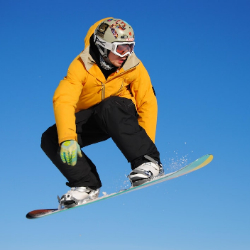![]()

When the temperature drops and snow begins to fall, many people can’t wait to hit the slopes or ice rink. Winter fun is on their minds, not any potential injury. Yet if thoughtful preparation for any favored activity is not made, it’s easy to have a mishap. January has long been recognized as the National Winter Sports Traumatic Brain Injury (TBI) Awareness Month. Harsh winter days offer thrill-seekers a playground of opportunity to participate in extreme sports such as snowboarding, skiing, and snowmobiling. The high velocity along with the living-on-the-edge sense of adventure makes these sports appealing to many.
Nearly 200,000 people were injured in 2018 while participating in winter sports, according to the US Consumer Product Safety Commission. Head injuries make up about 20% of these accidents (according to a study published in The Journal of Trauma and Acute Care Surgery), largely from snow skiing, snowboarding, ice skating, sledding and tobogganing. Sprains, strains, dislocations and fractures were common but also concussions and other head injuries.
A study published in The Orthopedic Journal of Sports Medicine examined the rates of head and neck injuries in three extreme winter sports (snowboarding, snow skiing, snowmobiling) and four extreme summer sports (surfing, skateboarding, mountain biking, and motocross). The study discovered some alarming statistics:
- More than 4 million injuries were reported in the seven sports between 2000 and 2011, 11% of which involved injuries to the head and neck.
- Skateboarding, snowboarding, skiing, and motocross had the highest number of head and neck injuries.
- Snowboarding and skiing combined accounted for 55% of the reported concussions from all seven sports.
- According to the U.S. Consumer Products Safety Commission, snowboarding is the leading cause of winter sports injuries.
Whether it’s a helmet, skis or skates, it’s essential to check your gear before heading out to make sure it’s in good condition. Proper winter attire is also key, as is having plenty of water on hand to combat dehydration, something that often goes unnoticed in winter. To help make winter sports adventure safer, the American Association of Orthopedic Surgeons suggest:
- Always wear a helmet for high-velocity sports; wear appropriate protective gear and outerwear to limit skin exposure
- Avoid overexposure to sub-freezing temperatures and stay informed about current weather conditions
- Stay in bounds on the slopes and watch for obstacles and hazardous conditions
Adolescents watch sporting events on television and often think flying through the air on a snowboard looks easy. They do not realize all the practice that they put into the sport, nor do they see how often athletes get injured while practicing and learning their stunts.
Enjoy the outdoors with friends instead of going by yourself; in case of an accident, help will be nearby to assist if there are injuries. Be aware of weather and terrain, especially early in the season when temperature fluctuations can affect snow and ice.
Do some stretching before beginning any activity to warm up muscles, and know your abilities in the sport that you find enjoyment. Take rest breaks and stop before becoming overtired; the time most likely to get injured skiing is on the last run because of fatigue. When fatigue occurs, technique is often ignored. Because so many winter sports can result in spills, learn how to fall properly. Don’t stick out your hands to try and break your fall; rather, tuck and roll so your upper body takes the brunt of the fall, hopefully preventing a catastrophic ligament tear or fracture.
Some winter sports injuries are more common in people of a certain sex or age. Many sledding and snowboarding injuries occur with younger people; snowmobiling injuries in middle-aged men and downhill skiing injuries in women often cause torn ACLs in the knee. Older adults tend to break bones in winter sports accidents, while younger adults suffer more strains and sprains.
If injured while participating in any extreme sport, seek diagnosis and treatment from a sports medicine physician, preferably one who is specialty-trained for musculoskeletal injuries. If a mild concussion is suspected, a diagnosis may require a neurological examination to test vision, hearing, strength, sensations, balance, coordination, reflexes, memory, as well as a cranial CT scan or MRI. If a joint is swollen or painful after a fall, see a physician; the same goes if a joint is numb, tingling or has acute weakness. Depending on the symptoms and severity of the injury, the injured party may be referred to a neurologist. Traumatic brain injuries are emergencies and require immediate treatment at the closest emergency room. After a blow to the head, watch for dizziness, visual disturbances, light intolerance, loss of memory and headaches. All of these indicate you should seek medical care.
